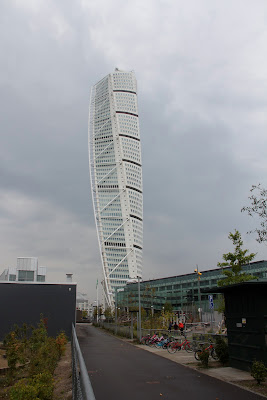you can't spend several weeks in Malmo and not take pictures of the Turning Torso. in fact, many would argue you can't spend several hours in Malmo and not take pictures of it. you may even recall that I took a picture of it
the first night I arrived in Malmo. once the tallest apartment building in Europe, the Turning Torso twists upward 54 stories and 623 feet, the top floor at a 90 degree angle from the ground floor. the Torso was envisioned by the government of Malmo as a new beginning, a fresh start, and a much needed strengthening of the skyline to the north of the city center. it rises 2 times higher than
Kronprinsen, the previous tallest building in Malmo.
 |
| the Turning Torso approached from the southern main access road to Vastra Hamnen from the city center. the Torso, designed by Santiago Calatrava, rises 623 feet and 54 stories. |
the
Kockums crane (Kockumskranen) which was sold to a Korean company in the early 2000's was the last and highest symbol of the working class city of Malmo's shipbuilding industry. it's last duty was to assist in the building of the Oresund Bridge, the lifeline connection between Copenhagen, Denmark and Malmo, Sweden.
 |
| looking up at the Torso from the street |
in the years leading up to the decision to construct the
Turning Torso, there were three major focused objectives of the city of Malmo, partly in an effort to move forward after the financial collapse caused by the shipbuilding industry abandoning the city (among other financial challenges), partly to jump into the 21st century, and partly to recreate and rebrand the city and its identity. the three objectives were, at first blush, quite simple:
- improve education and heighten the focus of the city on advanced education
- strengthen connectivity and interconnectedness of Malmo within the region of Skane and beyond
- use sustainability and sustainable initiatives as a method to advance the city and its planning
these three objectives were simultaneously addressed starting in the 1990's and moving into the first decade of the 21st century. though the Turning Torso was not, in itself, a cornerstone of any of these three specific objectives, it played a significant role as a new symbol of Malmo, the city of the future. the Torso is an excellent example of how cities use architecture (tall, unique, or important buildings, often designed by famous architects) to promote an agenda and "put themselves on the map" as Malmo has been doing for the last 15-20 years.
 |
| Turning Torso in Vastra Hamnen, Malmo as seen from the neighborhood |
the three most obvious physical manifestations of the three objectives are quite powerful, and together have helped shaped Malmo as a growing, changing city with an eye toward the future.
1. one of the brightest examples of the city of Malmo putting a new focus on higher education was the creation of Malmo's first University,
Malmo Hogskola. the University, now a central hub of the Dockans neighborhood adjacent to the central train station and Vastra Hamnen, has grown to more than 24,000 students in just over ten years of operation (the school opened officially in 1998). the school has many disciplines and areas of study, including several in sustainability such as master's degrees in "Leadership for Sustainability" and "Sustainable Urban Management".
 |
| the style has been called "structural expressionism" and is most evident in the exposed structural elements on the building exterior |
2. the most obvious physical manifestation of the idea of interconnection in Skane and beyond is the Oresund Bridge and the improvements in the train transportation into Malmo.
the Oresund Bridge, completed and opened in July 2000, has created amazing opportunities for growth in Malmo as well as the opportunity for people living in Malmo to commute easily to Copenhagen. besides the construction of the bridge itself, Malmo created new and improved train stations and rail lines from the bridge through the city center (called
the City Tunnel Project) that simplify, enhance, and speed up travel to and from Malmo as well as through it up the western coast of Sweden and beyond.
 |
| the Turning Torso sits in a pool of water at the base (the parking complex in the background contains a sustainable grocery store and restaurant on the ground floor) |
3. in terms of sustainability, the list, as you may have seen from earlier entries in this blog, is endless. I would argue that the most notable catalyst for the physical manifestation of making sustainability part of the city's future is Bo01, brought about as part of the European Housing Exposition in 2011, and evidenced in the
European Village as well as the surrounding neighborhood and corresponding infrastructure. this neighborhood, anchored on one corner by the tallest building in Scandinavia, is a beacon of hope for the future of sustainable cities and neighborhoods.
 |
| the Turning Torso as seen from the neighborhood school. the top is 90 degrees twisted from the base. |









